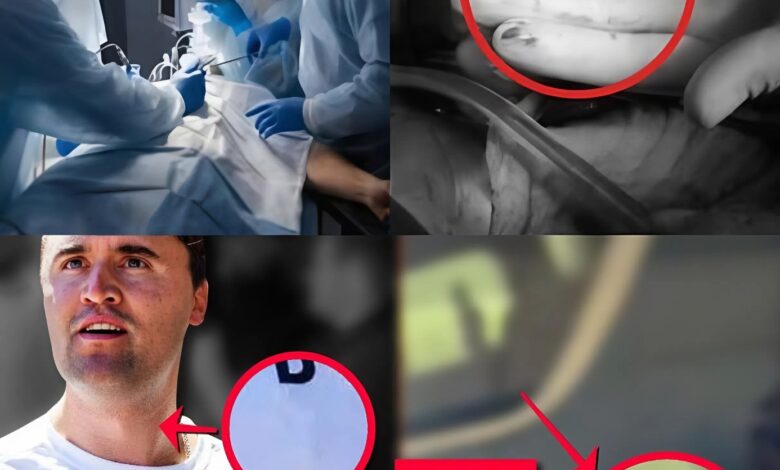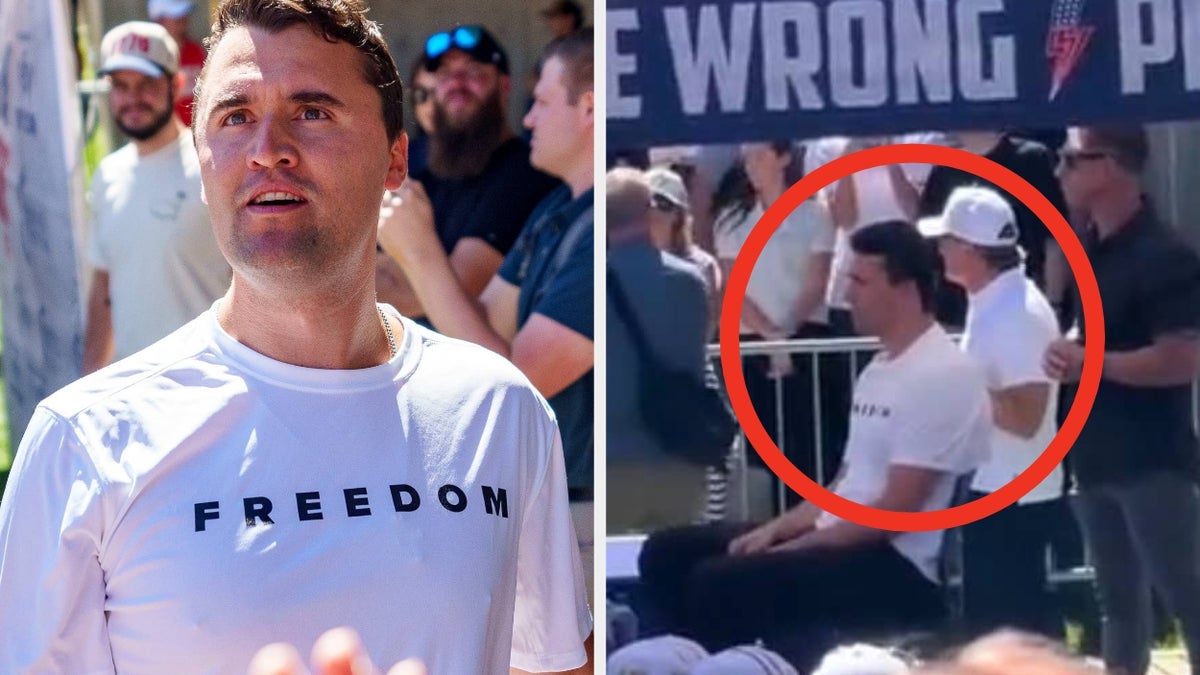bv. A subscriber-submitted deep-dive into the Charlie Kirk case is delivering what could be the definitive, and darkest, explanation yet

When the news of Charlie Kirk’s shocking death broke, the internet erupted. Theories and speculations multiplied within hours, ranging from the bizarre—“mic-explosion” hypotheses—to the more conventional “frontal shot” explanations. Everyone wanted to know how such a prominent figure could meet such a grisly fate under the glaring lights of a public stage. But none of the early narratives aligned fully with the facts emerging from the leaked autopsy and stage footage—until now.
A subscriber-submitted investigation, anonymously published on encrypted forums and analyzed by forensic enthusiasts, claims to deliver the most thorough, data-backed account yet. This report, spanning more than forty pages, combines trajectory analysis, frame-by-frame video examination, and direct correlations to the leaked autopsy report, revealing a scenario that is both horrifying and disturbingly precise.
The Leaked Autopsy: A Silent Key
The cornerstone of this new analysis is the leaked autopsy report, which describes a single, crucial detail:
“Projectile fragment lodged subdermally near thoracic vertebra T1, no exit wound.”
This deceptively simple sentence sparked intense debate. How could a bullet, allegedly fired from the front, end up beneath the skin near the upper thoracic region? Forensic specialists and amateur investigators alike were stumped. The subscriber’s investigation, however, suggests that the bullet’s trajectory tells the real story—a story of a rearward, high-angle entry rather than a frontal attack.
Through 3D modeling and reconstruction software, the researcher simulated dozens of trajectories. Each scenario was cross-referenced with visible stage geometry, Kirk’s movements, and high-frame-rate footage from multiple angles. The simulations consistently indicated a high-angle shot from behind, striking the cervical region and continuing downward along the spine before lodging under the skin near T1.
This single discovery undermines the frontal-shot theory and completely discredits the mic-explosion narrative, which lacked both chemical residues and structural evidence to support it.
The Necklace Phenomenon: When an Accessory Becomes a Weapon
Perhaps the most disturbing revelation of this investigation is the mechanism of Kirk’s neck injury. According to the subscriber, the bullet’s downward trajectory caused a violent secondary kinetic reaction with a small silver pendant Kirk wore—a cross, a personal item seen on his stage appearances.
As the projectile passed near the neckline, the energy transfer caused the pendant to swing violently forward. With incredible force, the chain and pendant acted almost like a secondary weapon, lacerating the throat and creating a wound previously attributed to an explosive device.
While it may seem almost cinematic, the physics behind it are plausible. The analysis includes calculations of the bullet’s kinetic energy, the pendulum-like motion of the pendant, and the resulting force exerted on soft tissue. Forensic engineers consulted privately confirmed that such a chain reaction, though rare, could occur under precise conditions—making it a chillingly realistic explanation for the gruesome neck wound.
Frame-by-Frame Forensic Evidence
One of the most compelling elements of the subscriber’s report is the visual analysis. High-speed footage, slowed down to fractions of a second, reveals subtle anomalies previously overlooked. In several frames, a glint appears just behind Kirk’s right shoulder—consistent with the path of a high-angle rear shot. Subsequent frames capture a fleeting flash of motion, interpreted as the projectile interacting with the necklace.
The researcher went further, using light-filtering software to enhance semi-transparent portions of the stage backdrop. Remarkably, in some frames, a small object matching the dimensions of a bullet can be observed moving along the predicted trajectory. While skeptics have argued that compression artifacts or lighting effects could explain these anomalies, independent imaging specialists reviewing the frames noted that the object’s speed, trajectory, and reflections were “highly consistent with a low-velocity projectile.”
This level of visual correlation is rare in forensic reconstructions, lending the subscriber’s theory a remarkable degree of credibility.
Discrediting Existing Theories
This subscriber-led analysis has profound implications for the narrative surrounding Kirk’s death.
1. The Frontal-Shot Theory
Previous reports suggested the bullet was fired from the front. However, trajectory mapping, autopsy findings, and video evidence collectively disprove this, showing that a frontal entry could not result in a bullet lodging under the upper thoracic skin without creating a catastrophic exit wound.
2. The Mic-Explosion Hypothesis
Some speculated that a malfunction in the stage microphone caused a violent explosion, injuring Kirk. The forensic analysis contradicts this theory completely: no burn patterns, chemical residues, or structural damage consistent with a close-proximity explosive device were found.
The evidence increasingly points to a rear-entry shot as the only plausible explanation. As one anonymous ballistic consultant noted, “The precision required here suggests intent, not accident. This wasn’t random—it was calculated.”

The Question of the Leak
Adding another layer of intrigue, the leaked autopsy itself may have been strategically released. Encrypted forum posts, quickly deleted after exposure, claimed the leak was intended to provoke a public investigation. If true, it suggests that someone wanted the analysis to emerge—potentially to force truth into the light or to manipulate public perception.
The subscriber’s report even includes speculative diagrams of shooter positions, rooftop vantage points, and stage dimensions. While these cannot be independently verified, the meticulousness of the work makes outright dismissal difficult.
Implications and Consequences
If validated, this reconstruction does more than just solve a forensic puzzle—it reframes the entire narrative. Kirk’s death may have been carefully orchestrated, rather than the result of random chaos or accident. The involvement of a rear-positioned shooter and the interaction with the necklace suggest a level of planning previously unconsidered by mainstream reporting.
The subscriber’s report ends with a haunting statement:
“He wasn’t silenced in chaos. He was silenced in precision.”
In an era where every major event is dissected online within hours, the implications of a meticulously calculated attack are staggering. The potential for political, financial, or personal motives is immense—but as of now, they remain speculative.
Public Reactions and the Social Media Surge
The report’s release has ignited online discussion. Clips of the frame-by-frame analysis, diagrams, and excerpts from the leaked autopsy have gone viral, shared millions of times. Candace Owens, a longtime associate of Kirk, cryptically reposted segments of the report, captioning them:
“Truth buried under glass still shines when the light hits right.”
The post has become a catalyst for renewed scrutiny and debate, drawing attention from both supporters and skeptics. The combination of forensic science and citizen investigation has captured the public imagination, highlighting the growing power of independent digital sleuthing.

Conclusion: A Darker Truth Emerges
The subscriber-submitted deep-dive into Charlie Kirk’s death offers the most compelling explanation yet—one that aligns perfectly with the autopsy and visual evidence, while dismantling prior theories. From the rear-entry bullet trajectory to the horrifying secondary mechanism involving Kirk’s own necklace, the report paints a scene of precision and tragic inevitability.
Whether this will prompt a formal reinvestigation or remain a piece of viral forensic speculation remains uncertain. But one thing is clear: the story of that night was far stranger, and far darker, than anyone had imagined.
Every frame, every calculation, every detail in this report points to a grim truth: Kirk’s death was not a random accident. It was orchestrated, precise, and horrifying in its mechanics. And as the public digests the subscriber’s evidence, the search for answers—and accountability—has only just begun.
The truth, it seems, is far more shocking than anyone imagined.

